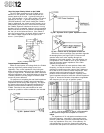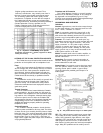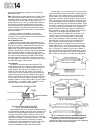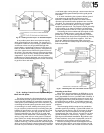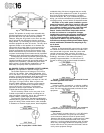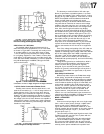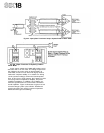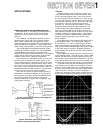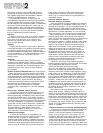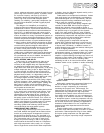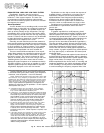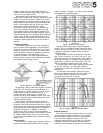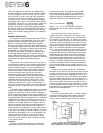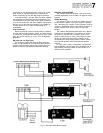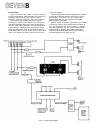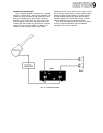
8-ohm load, it must be rated at 366 watts (power is
proportional to voltage squared). Since the P-2200 is
only capable of 230 watts, this waveform is clipped,
especially the high-frequency component.
If the same two waveforms in Figure 65A and
Figure 65B were reproduced by two separate amplifiers,
the total amplifier power capacity needed would only
be 246 watts (the sum of the two powers), not 366 watts.
This power could be provided by one P-2200 and one
smaller amplifier. Thus, using two power amplifiers to
produce these two waveforms reduces needed amplifier
power capacity. Or, if you use two P-2200 amplifiers,
there is a substantial increase in headroom.
Efficiency
A passive crossover is made up of resistors, capacitors,
and inductors. The resistors in the crossover "use up"
some power as do the losses in the capacitors and
inductors. By removing the passive crossover, these
losses are also removed.
Damping
Damping was discussed on Page FOUR 7. With refer-
ence to that discussion, any impedance inserted between
an amplifier's output terminals and a speaker's input
terminals reduces the damping factor; a passive crossover
is such an impedance. Thus, biamplification, by remov-
ing the passive crossover, improves the effective
damping factor.
Distortion
It is conceivable that a passive crossover could
introduce some distortion which could be avoided by
removing the crossover. However, the greatest reduction
of distortion comes with the increased headroom in bi-
amplified
systems,
which
means
less
peak
clipping
in
the amplifiers.
Dynamic Frequency Response Shift (also Page FOUR 6)
When the peaks of a complex waveform are clipped
off by inadequate headroom, two things happen. First,
since these peaks are usually high frequency information
(see Headroom discussion), the high frequencies are lost,
or reduced severely. At the same time, the clipping
creates new harmonics of the input frequencies. These
two factors can be considered to be changing the
frequency response of the system on a dynamic
(changing) basis, depending on the amount of clipping
present.
When to Use a Traditional, Passive Crossover
In small sound systems, where high sound levels are
not needed and economy is a major consideration, a
speaker
system
with
a
traditional,
passive
crossover
net-
work may be the best choice. For example, Yamaha's
S4115H and S0112T are excellent as stage monitors, or
as main speaker systems for small to medium sized clubs.
For larger installations, a biamplified or triamplified
system will not only perform better than a system with
passive
crossovers,
but
will
probably cost
less
too;
the
increased efficiency and headroom allows fewer
amplifiers and speakers to produce the same sound
level, and fewer crossovers are required.
Realizing the Advantages
To realize the advantages of a biamplified or tri-
amplified system, the electronic crossover must be able
to work well with a variety of different power
amplifiers and speaker systems. In addition, because it
plays a critical role in the sound system, the electronic
crossover must be highly reliable, and its performance
must be as good, or better than any other component
in the system. Yamaha's F1030 electronic frequency
dividing network (electronic crossover) meets these
needs. It is an excellent choice for any biamplified or
triamplified system.
Criteria for Biamped Systems
Crossover Frequency and Slope:
There is a freedom of choice available to the designer
of the biamplified (or triamplified) system that is not
available to the designer of a non-biamplified system. The
added advantage of being able to choose crossover fre-
quency and slope means that the system can be carefully
optimized for a specific application, or it can be made
highly versatile for use in a wide variety of applications.
Most manufacturers of quality speaker components
carefully specify both power capacity and frequency
range. The choice of crossover frequency can be based on
this information. For example, if a high frequency
driver's power capacity is rated at 20 watts of pink noise
from 2kHz to 20kHz, a crossover frequency of 2kHz or
higher is a good choice. A lower crossover frequency
might allow over-excursion of the driver's diaphragm,
leading to premature failure. If the system is bi-
amplified, the woofer will be chosen to complement
the high frequency driver's response. If the system is
triamplified, both a woofer and a midrange driver or a
super tweeter must be selected so that the frequency
ranges of all the components complement each other.
Preferably, there should be some overlap in the fre-
quency range of each successive driver.
The choice of crossover slope involves a tradeoff
between speaker protection and phase shift. A low slope
rate
of
6dB/octave
will
produce
a
smooth
system
response
with
minimum
phase
shift,
but it may not adequately protect high frequency
drivers from excessive low frequency energy or low
frequency drivers from excessive high frequency energy.
A high slope rate of 24dB/octave or higher will protect
the drivers better, but can introduce more phase shift
than a crossover with a lower slope rate. 12dB/octave
and 18dB/octave are widely used, and are good com-
promises. 12dB/octave is the most common choice, but
18dB/octave can provide a little "extra protection" for
sensitive components, especially high frequency drivers.
Again, decisions should be based on a careful study of
the abilities of the individual components, and of the
system requirements.
One common method of designing a three way
system (with woofers, midrange, and high frequency
drivers) is to biamp the system between the woofers and
midrange, and to then use a passive, high level crossover
between the mid and high frequency drivers. Since there
is generally less energy in the high frequency range, the
extra headroom and efficiency that would be obtained
by triamping may not be needed. This compromise will
usually
save
money
without
adversely
affecting perfor-
mance or reliability.
Criteria for Selection of a Crossover (Dividing Network)
There are only a few passive, high level crossovers on
the market that are suitable for professional sound
systems.
Those
that
are
built
into
a
finished
speaker
system, such as Yamaha's S4115H and S0112T, are
exceptions. Because of the limited selection, a custom
designed
system
with
passive
high
level
crossovers
usually has to be designed around the crossover instead
of around the drivers. Still, the crossover should meet
certain criteria. It should have an impedance equal to the
desired speaker system impedance (the impedance of the



